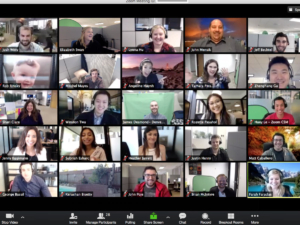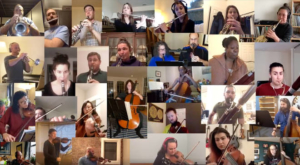
The COVID-19 pandemic has spelled disaster for many economic sectors, but a boon for others such as orange juice, grocery delivery and video conferencing. Perhaps no company is booming more than Zoom Video Communications.
Video conferencing apps were downloaded an astounding 62 million times globally during a single week in March when lockdowns were put in place around the world. While there are many top-notch competitors, Zoom has been downloaded at exponentially higher rates than Google’s Hangout and Microsoft’s Team.
Video conferencing has advanced a significant distance from Apple’s Facetime, a favorite of grandparents talking face-to-face with grandkids in another state or couples separated by distance. The most potent difference is the simultaneous ability to loop in large groups of people (99 users for Zoom), which has proven invaluable for teams of people working remotely or students taking online classes. To maintain social distancing, video conferencing also has been used for church services, live performances, fundraisers, stag parties and even dates.
Zoom’s founder and CEO Eric Yuan says he created the popular app to “make everyone happy”. The app’s popularity has made Yuan a rich man, ranking just ahead of George Soros, George Lucas and Richard Branson on Bloomberg’s billionaire index.
Zoom’s sudden rise has attracted critics who claim the app poses significant security and privacy issues. The FBI has issued a warning about video conferencing hijacking (known as Zoom-bombing). The New York attorney general has sent Zoom a letter inquiring about the company’s security and privacy safeguards. And a class action suit has been filed in California alleging Zoom is allowing third parties to use personal data without user consent.
Yuan has apologized. “I really messed up. We did not design the product with the foresight that, in a matter of weeks, every person in the world would suddenly be working, studying and socializing from home. We now have a much broader set of users who are utilizing our product in a myriad of unexpected ways, presenting us with challenges we did not anticipate when the platform was conceived.”


Despite concerns, the Zoom app is getting a workout in the unexpected ways Yuan mentioned, including by performing artists. A Los Angeles artistic director, who had experience with Zoom video conferencing in a previous job, turned to the technology to allow a group of six actors to perform a play to a digital audience. A 24-member student orchestra created a viral sensation by individually performing “See You Again” and having it edited into a virtual performance. The Toronto Symphony assembled on Zoom to perform an excerpt from “Appalachian Spring”. Rumors are circulating that a movie is in the works using “Zoomification”.
Video conferencing has been around for a decade or more, mostly as the province of businesses seeking to avoid time-consuming and costly travel to attend meetings at corporate headquarters. The rise of Zoom usage by a wider cadre of people suggests that video teleconferencing may represent a more fundamental shift in our business and social interactions. Family reunions, for example, could occur with ease more often, with less planning and no potato salad side dishes required. Simultaneous presentations by physically separated team members would be possible. Collaborative projects could continue from remote locations. Security concerns may be addressed soon with full encryption, according to Yuan.
Ann Hornaday, movie critic for The Washington Post, observes that Zoom “has quickly become so ubiquitous and so reflexively accepted” that it is hard to imagine it won’t infiltrate broad swaths of society. It doesn’t hurt that virtual meetings on Zoom with up to 100 people that last 40 minutes or less are free, and the product performance isn’t intentionally stunted to encourage subscribing to the full-blown version. Or, as Zoom puts it on billboards, “Video conferencing that doesn’t suck”.
Zoom already has a huge foothold in US universities and its business use is growing organically. Somebody schedules a Zoom meeting and invites participants to sign up. To put that organic growth in perspective, 3 million people participated in Zoom meetings in 2013. Now, on average, 1 million people dial into Zoom meetings daily.
If you have toyed with video conferencing in the past and met with disappointment because of its clunkiness and technical glitches, the new wave of tools offers a better, more robust experience. The communal lockdown of much of the world is a perfect time to bone up on how to exploit this new tool that makes social distancing seem less isolating.
You might even create a virtual clubhouse and host a Zoom party.
Young Girl Gets ‘Hamilton’ Cast Performance on her Birthday

The girl and her parents had tickets for the hit Broadway show in Jacksonville, but the show was canceled because of the COVID-19 pandemic. John Krasinski, host of SGN, an online show devoted to highlighting good news, saw a social media post from the girl’s mother and immediately contacted Lin-Manuel Miranda. After promising the girl and her family tickets for the New York production of the musical, Kransinki let Miranda “Zoom-bomb” the interview for a virtual preview of the popular play.
A nine-year-old Florida girl got an expected virtual birthday surprise when the cast of “Hamilton” performed via video conference.

Gary Conkling is principal and co-founder of CFM Strategic Communications, and he leads the firm’s PR practice, specializing in crisis communications. He is a former journalist, who later worked on Capitol Hill and represented a major Oregon company. But most importantly, he’s a die-hard Ducks fan. You can reach Gary at garyc@cfmpdx.com and you can follow him on Twitter at @GaryConkling.



